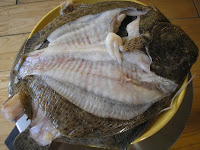I bought an ugly fish (zeeduivel a.k.a. sea devil, monkfish, angler fish) and had them clean it and give me the head and bones so I could make some fish stock (a.k.a. fumet). They asked if I wanted some more fish carcases, so I came away with a couple of small turbots at no extra cost. Like I said, nice service.
After checking out some recipes and advice on the internet, this is the fumet I made. It turned out very flavourful, perfect for a lovely Italian fish soup that I plan to make soon. And that fish pie recipe I still need to perfect.
Fish Fumet
- 1.5 - 2 kilos fish heads and bones of white-fleshed fish, such as founder, turbot, halibut, or cod
- 1 large onion
- 1 leek
- 1 stalk celery
- 1/2 fennel bulb
- 3-4 mushrooms
- 1 tablespoon butter
- 1 tablespoon oil
- 2 bay leaves
- 12 white pepper corns
- 1/2 teaspoon salt
- 1 1/2 cup white wine
- 6 cups water
- Remove the eyes from the fish heads (I know, not one the nicer tasks). Apparently, they can cause the stock to become bitter if they burst. I also removed the rather slimy, dark skin from the angler fish, as one bit of advice said that fish skin can also make the stock dark and cloudy. So can blood left in large veins in the heads, so soak the fish carcases in cold water for some hours, and then discard the water.
- Finely dice the onions, celery, leek, fennel, and mushrooms.
- Heat the oil and butter over medium high heat and when the foam from the butter subsides, add the vegetables,bay leaf, parsley, salt and pepper and give a stir.
- Add the fish carcases and cover for 5-7 minutes, until the flesh on on fish flakes. Basically the fish steams in its own moisture, along with the vegetable aromatics.
- Now add the wine a cook for a few minutes to allow the alcohol to evaporate.
- Then add the water. Bring to a gentle simmer and simmer for 20-30 minutes, skimming off the foam that rises to the surface.
- Place some muslin or several layers of cheese cloth in a sieve and strain the stock into another pot. Press down on the fish an vegetables to extract all the moisture and flavour.
- At this point, you can adjust the seasonings and use the stock in a fish soup or sauce, or freeze it. I decided to reduce it further to concentrate the flavour more (and reduce the amount I'd have to store in the freezer!)








